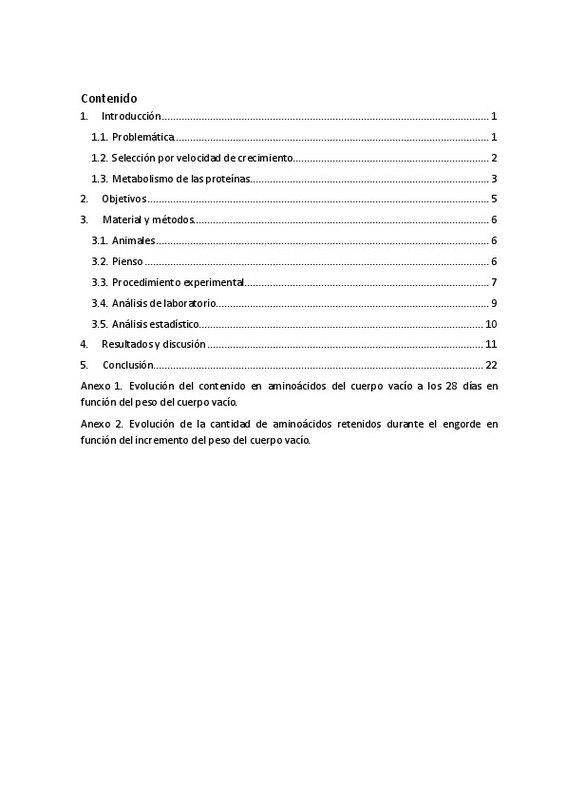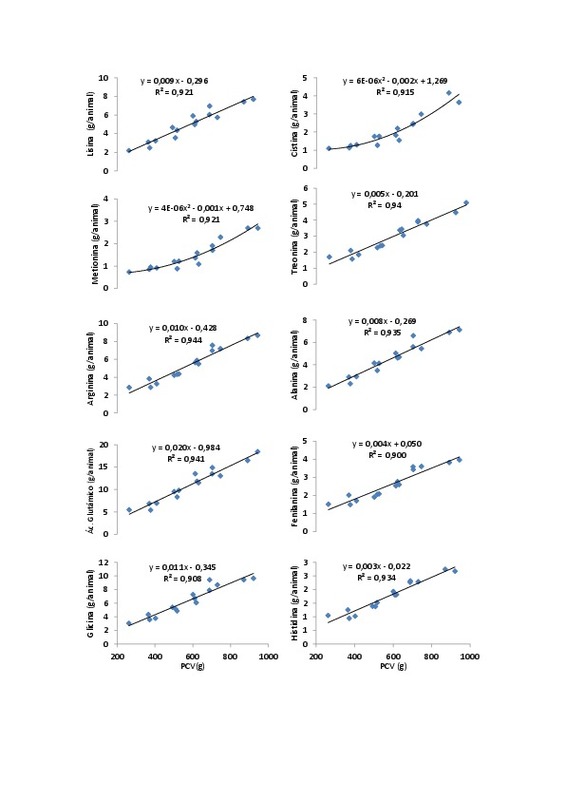JavaScript is disabled for your browser. Some features of this site may not work without it.
Buscar en RiuNet
Listar
Mi cuenta
Estadísticas
Ayuda RiuNet
Admin. UPV
Efecto de la velocidad de crecimiento sobre el balance proteico de los conejos durante el engorde RESUMEN
Mostrar el registro sencillo del ítem
Ficheros en el ítem
| dc.contributor.advisor | Pascual Amorós, Juan José
|
es_ES |
| dc.contributor.author | Díaz Acuña, Yésica María
|
es_ES |
| dc.date.accessioned | 2014-06-09T11:13:45Z | |
| dc.date.available | 2014-06-09T11:13:45Z | |
| dc.date.created | 2013-09-27 | |
| dc.date.issued | 2014-06-09 | |
| dc.identifier.uri | http://hdl.handle.net/10251/37998 | |
| dc.description.abstract | [ES] Durante las últimas décadas la nutrición proteica de los conejos ha mejorado considerablemente. Sin embargo, la mayoría de los piensos son diseñados para cubrir las necesidades de animales cruzados que muestran un crecimiento y necesidades inferiores a los seleccionados por velocidad de crecimiento. Además, la irrupción de la enteropatía mucoide ha originado la necesidad de reducir el porcentaje de proteína que llevan los piensos. Ante estas circunstancias existe el riesgo de que los piensos actuales puedan dificultar la expresión del potencial genético de los animales con una alta velocidad de crecimiento. El objetivo del presente trabajo es evaluar como el tipo genético y la velocidad de crecimiento individual puede haber afectado a la ingestión y la retención de proteína y aminoácidos durante el período de engorde. Para la determinación del balance proteico y en aminoácidos durante el engorde se utilizaron 58 gazapos recién destetados (28 días) de tres tipos genéticos (H, LP y R). El primer día de destete se realizó el sacrificio de 15 animales (5 de cada tipo genético); el resto de los animales fueron engordados (hasta su sacrificio a los 63 días) con un pienso que cumplía con las recomendaciones para conejos de engorde, pero utilizando los niveles de recomendación mínimos. Durante el engorde los animales de la línea R mostraron una mayor ingestión de materia seca y de proteína en comparación con las otras dos líneas (+35%; P<0.05; análisis sin covariable). Esto llevó a que la línea R tuviera un peso de cuerpo vacío superior a los 63 días de vida, pero al introducir como covariable la GMD estas diferencias desaparecen e incluso muestran una ingestión menor a la esperada. Respecto a la cantidad de proteína retenida se observó que los animales de la línea R retienen significativamente más que la línea LP (+2 g/d; P<0.05) y ésta respecto de la línea H (+1 g/d; P<0.05). Estas disparidades se deben única y exclusivamente a sus diferencias en ganancia media diaria y a que al introducir a ésta como covariable explicaría la totalidad de la variabilidad (+0.25 g de proteína retenida por g de GMD; P<0.001). Además se observó que al relacionar la evolución de la proteína retenida en función de la ganancia del cuerpo vacío (¿PCV) hay inicialmente una tendencia lineal entre los 20 y 40 g de ¿PCV y a partir de ese momento aparece un comportamiento cuadrático; por lo que, a partir de ese momento (>55 g) los animales mostrarían deficiencias en alguno de los aminoácidos limitantes. Dichas determinaciones muestran la necesidad de aumentar entorno a 1.5% el contenido en proteína digestible de los piensos destinados a la alimentación de machos seleccionados por velocidad de crecimiento | es_ES |
| dc.description.abstract | [EN] During the last decades the protein nutrition of rabbits has improved considerably. However, main of feeds are designed to meet the requirements of crossbred animals, showing lower growth and needs to those selected for growth rate. Moreover, the entry of mucoid enteropathy has created the need to reduce the percentage of dietary protein. Thus, there is a risk that the actual feed may restrict expression of genetic potential of the animals with a high growth rate. The aim of this study is to evaluate how genetic type and individual growth rate could have affected feed intake and retention of protein and amino acids during the fattening period. To obtain the protein and amino acid balance during the fattening 58 young rabbits (28 days) of three genetic type (H, LP and R) were used. The first day of weaning 15 animals were slaughtered (5 of each genetic type), the rest of the animals were fed (until slaughter at 63 days) with a feed that satisfy recommendations for fattening rabbits, but using recommendations at minimum levels. During fattening animals R line showed an increased intake of dry matter and protein compared to the other two lines (+35%, P<0.05, analysis without covariate). This led to the R line had a higher empty body weight at 63 days of life, but as a covariate to enter the ADG these differences disappear and even show a lower than expected intake. Relative to the amount of protein retained observed that animals retain R line significantly more than the line LP (+2 g/d, P<0.05) and this to the line H (+1 g/d, P<0.05). These disparities are due solely to differences in average daily gain since introducing it as a covariate to explain all of the variability (+0.25 g of protein retained per g of ADG, P<0.001). It was also observed that the evolution of body retained protein in function of the empty body weight (¿EBW) was initially linear -between 20 and 40 g of ¿EBW -, and thereafter appears a quadratic trend, so animals would show deficiencies in any of the limiting aminoacids from this time (>55 g). These results showed the need to increase around 1.5% digestible protein content of males¿ feed when selected for growth rate. | es_ES |
| dc.format.extent | 29 | es_ES |
| dc.language | Español | es_ES |
| dc.publisher | Universitat Politècnica de València | es_ES |
| dc.rights | Reconocimiento - No comercial - Sin obra derivada (by-nc-nd) | es_ES |
| dc.subject | Conejo | es_ES |
| dc.subject | Engorde | es_ES |
| dc.subject | Velocidad de crecimiento | es_ES |
| dc.subject | Proteína | es_ES |
| dc.subject | Aminoácidos | es_ES |
| dc.subject | Rabbit | es_ES |
| dc.subject | Fattening | es_ES |
| dc.subject | Growth rate | es_ES |
| dc.subject | Protein | es_ES |
| dc.subject | Aminoacids | es_ES |
| dc.subject.classification | NUTRICION Y BROMATOLOGIA | es_ES |
| dc.subject.classification | PRODUCCION ANIMAL | es_ES |
| dc.subject.other | Máster Universitario en Producción Animal-Màster Universitari en Producció Animal | es_ES |
| dc.title | Efecto de la velocidad de crecimiento sobre el balance proteico de los conejos durante el engorde RESUMEN | es_ES |
| dc.type | Tesis de máster | es_ES |
| dc.rights.accessRights | Abierto | es_ES |
| dc.contributor.affiliation | Universitat Politècnica de València. Servicio de Alumnado - Servei d'Alumnat | es_ES |
| dc.description.bibliographicCitation | Díaz Acuña, YM. (2013). Efecto de la velocidad de crecimiento sobre el balance proteico de los conejos durante el engorde RESUMEN. http://hdl.handle.net/10251/37998 | es_ES |
| dc.description.accrualMethod | Archivo delegado | es_ES |







